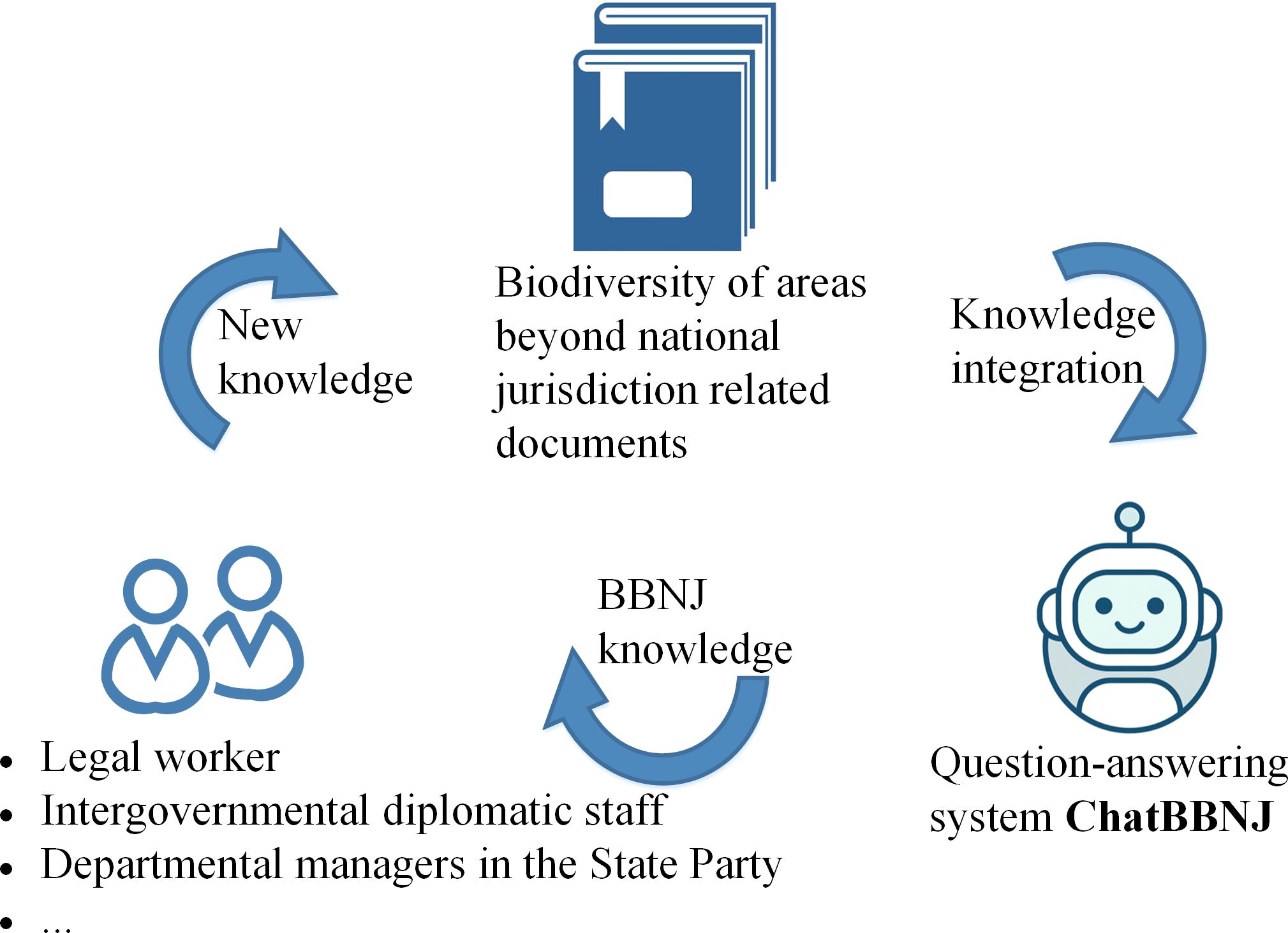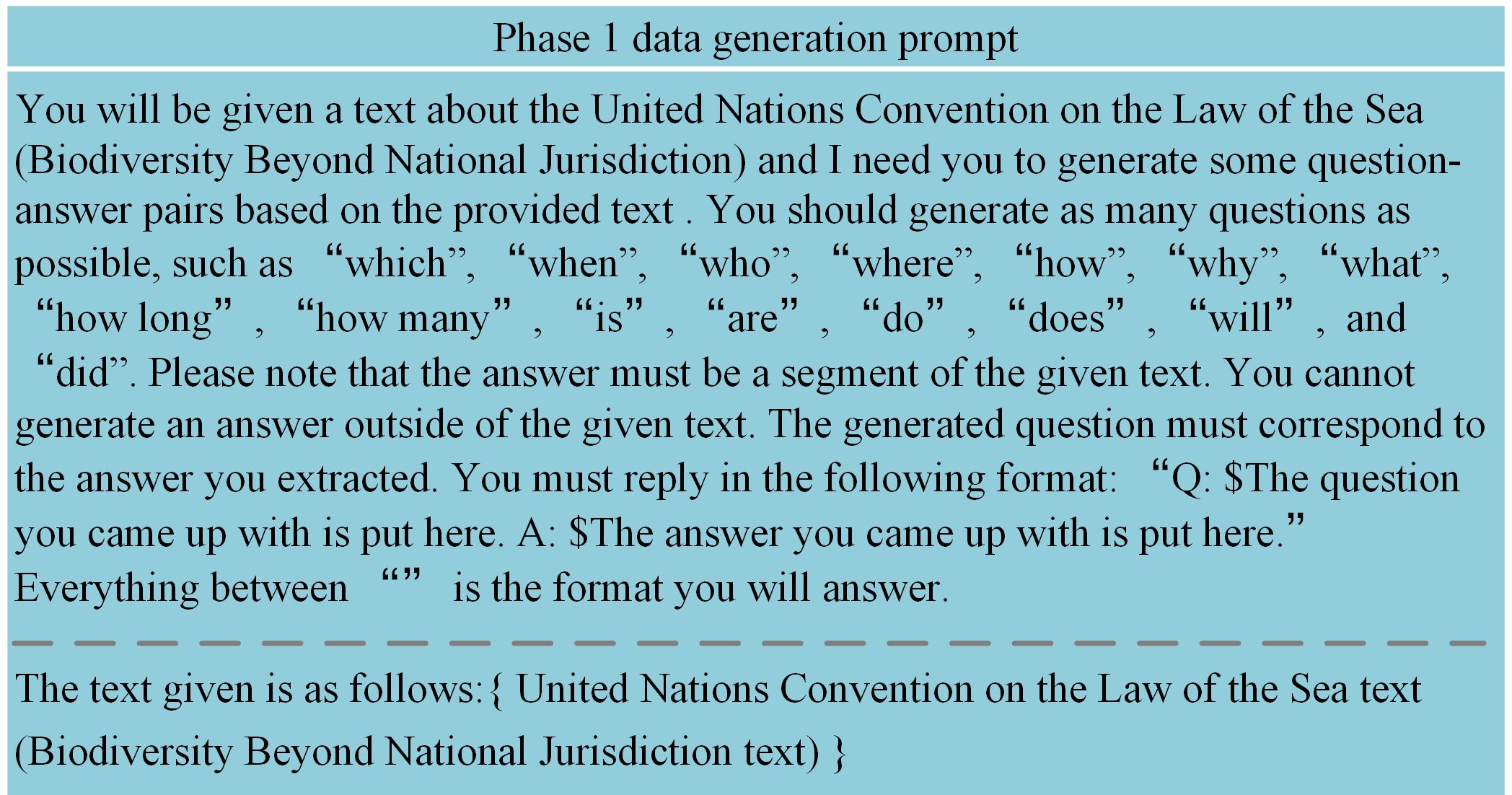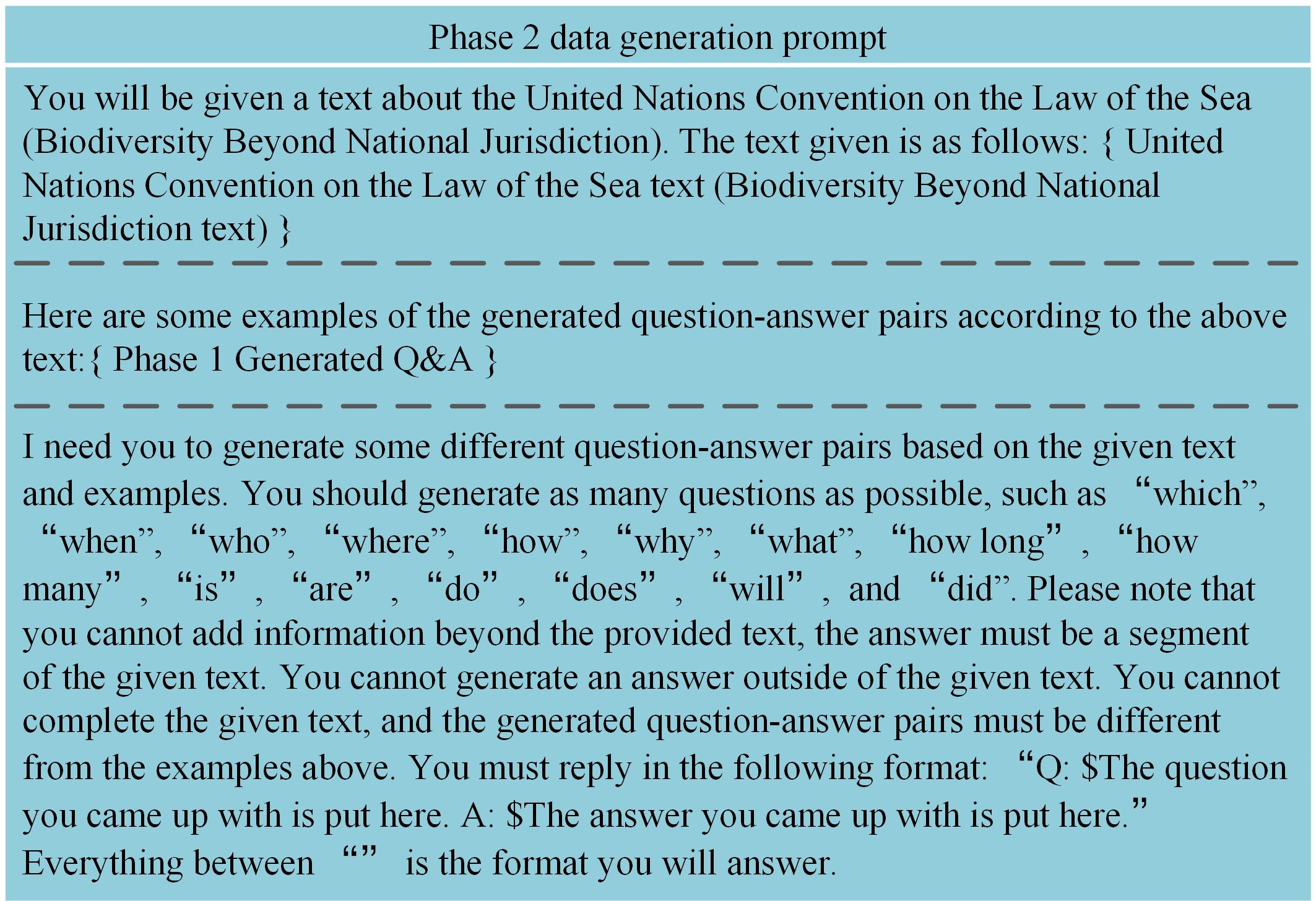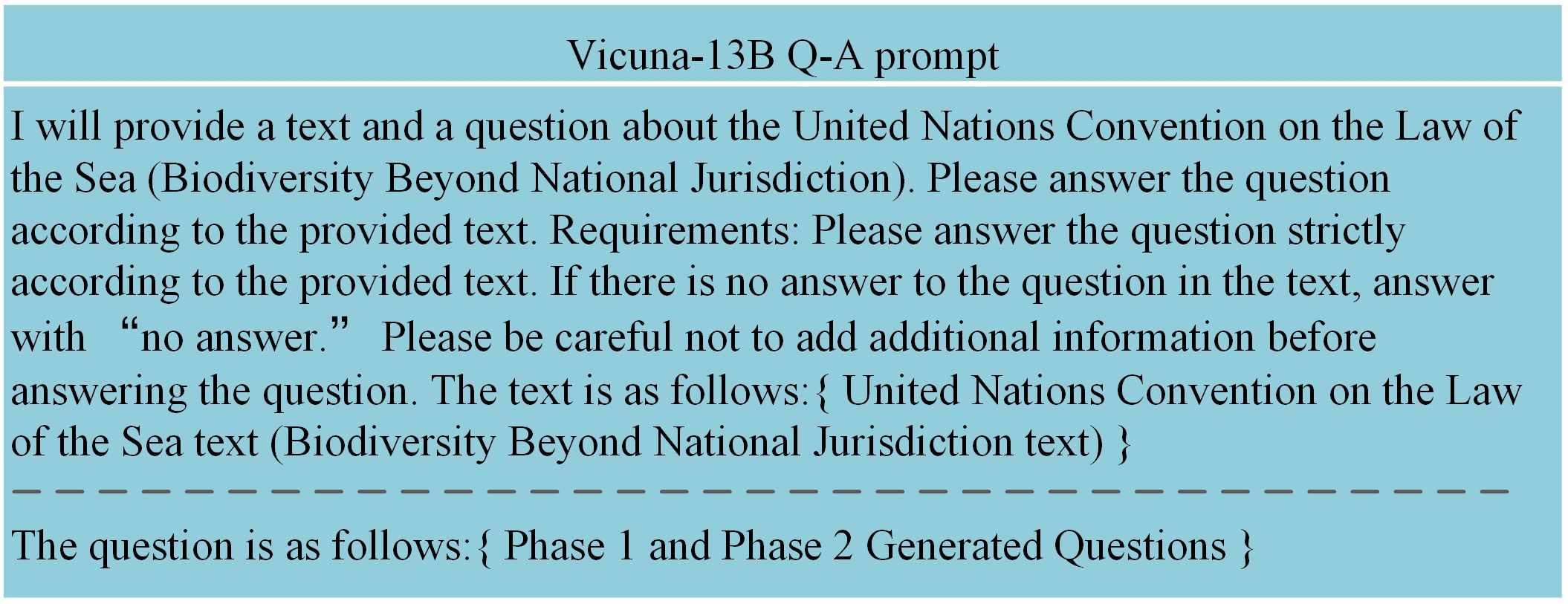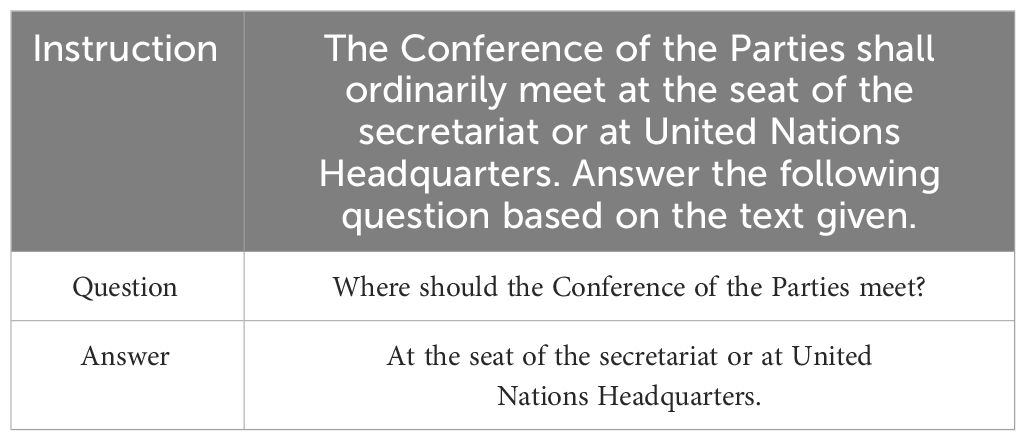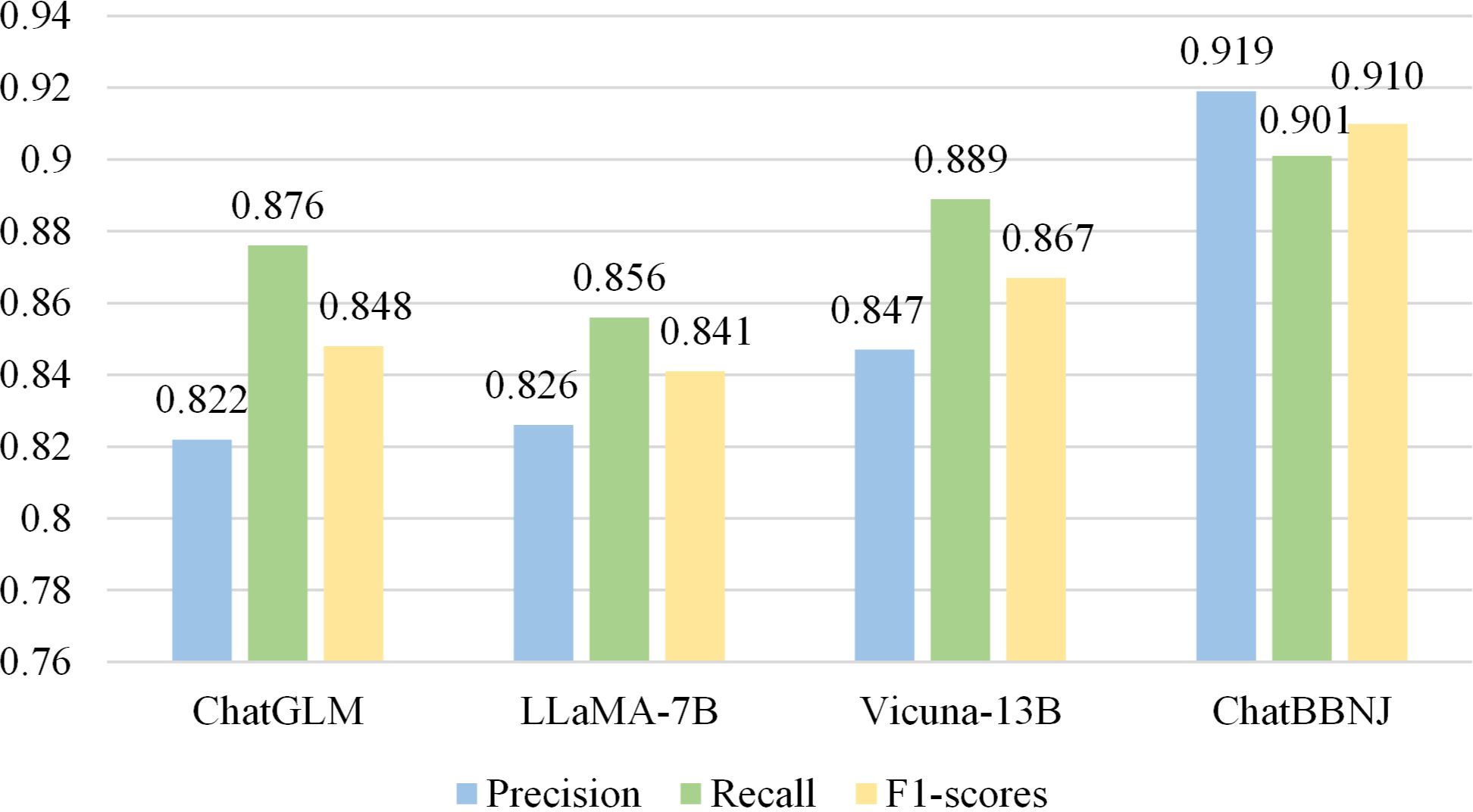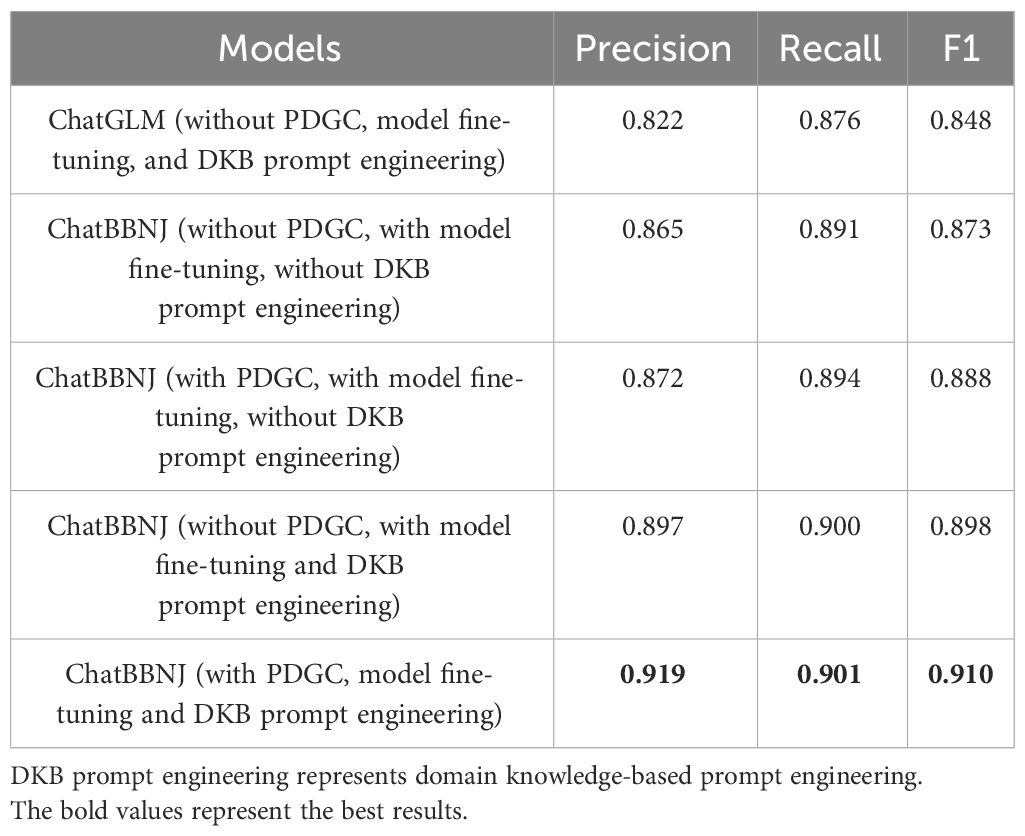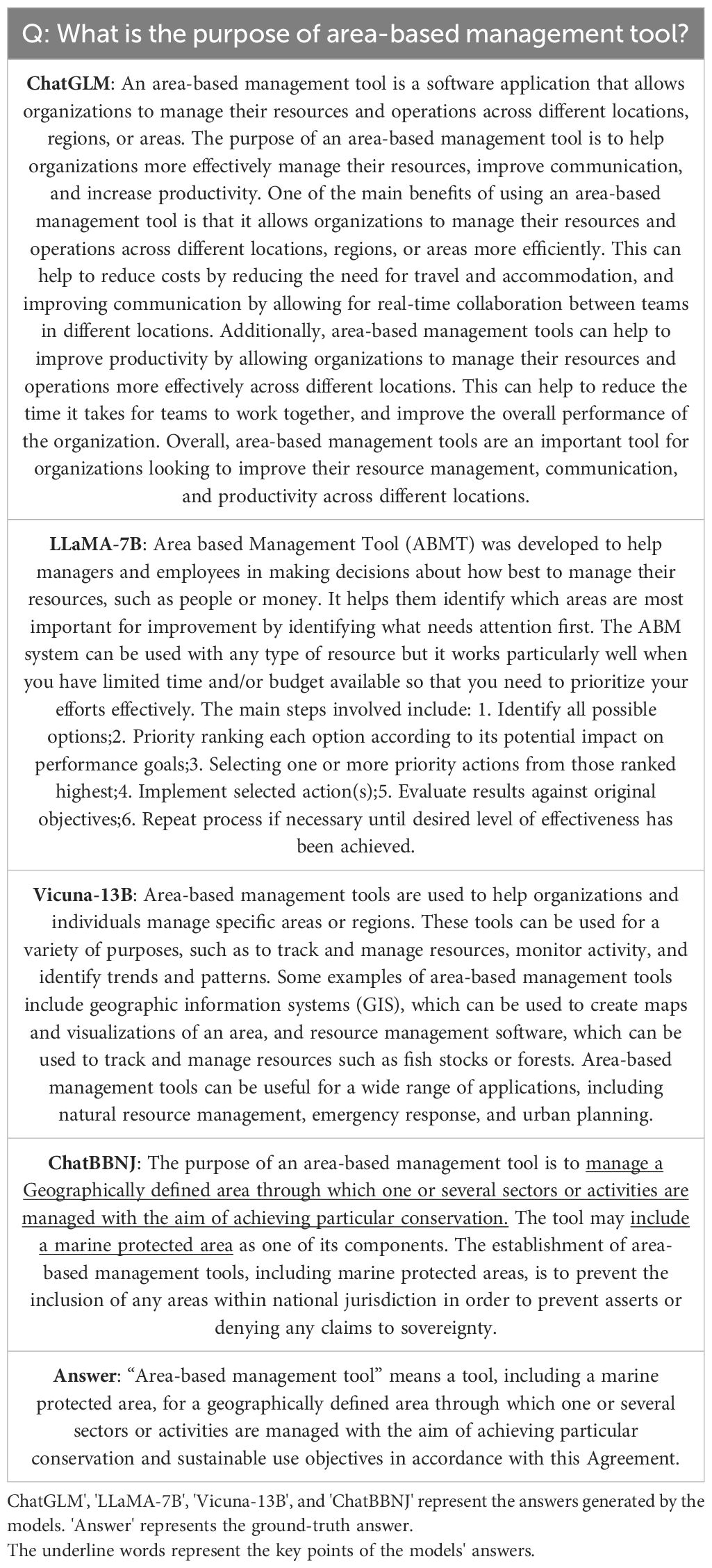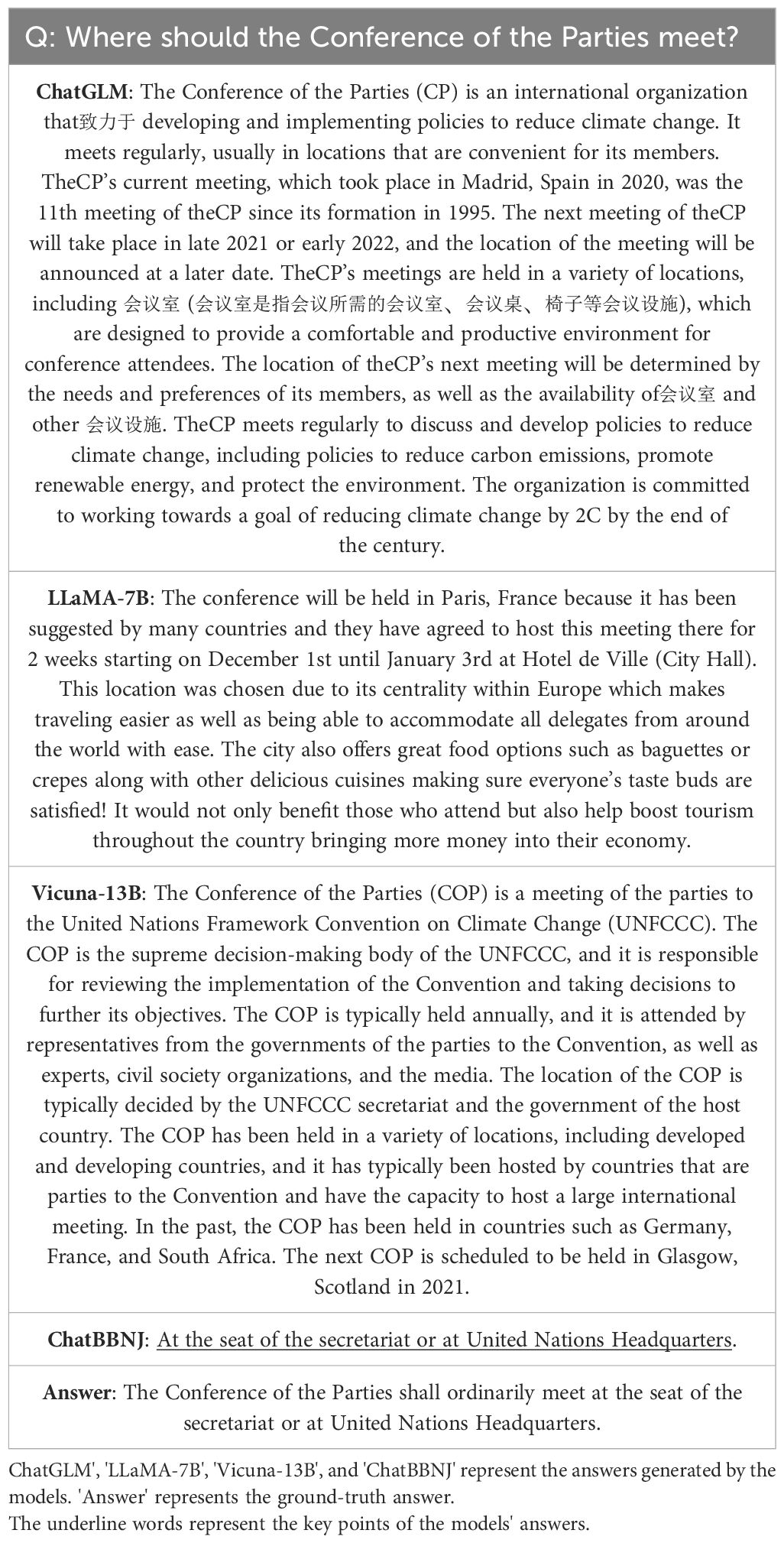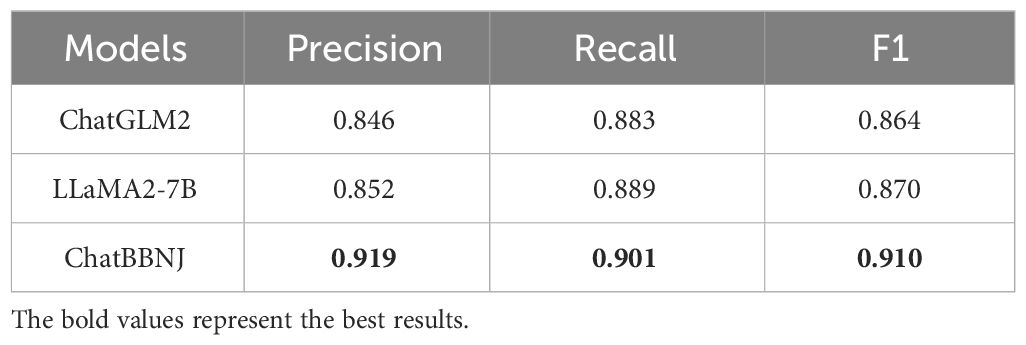- 1College of Computer Science and Technology, Ocean University of China, Qingdao, China
- 2Law School, Ocean University of China, Qingdao, China
The marine biodiversity in Areas beyond national jurisdiction (ABNJ), encompassing approximately two-thirds of the global ocean, is persistently declining. In 2023, the agreement on the Conservation and Sustainable Use of Marine Biodiversity of Areas Beyond National Jurisdiction (BBNJ) was officially adopted. Implementing the BBNJ Agreement has the potential to effectively meet global needs for preserving marine biodiversity. Nevertheless, the implementation requires dealing with thousands of legal clauses, and the parties participating in the process lack adequate means to acquire knowledge connected to BBNJ. This paper introduces ChatBBNJ, a highly efficient question-answering system that combines a novel data engineering technique with large language models (LLMs) of Natural Language Processing (NLP). The system aims to efficiently provide stakeholders with BBNJ-related knowledge, thereby facilitating and enhancing their comprehension and involvement with the subject matter. The experimental results demonstrate that the proposed ChatBBNJ exhibits superior expertise in the BBNJ domain, outperforming baseline models in terms of precision, recall, and F1-scores. The successful deployment of the suggested system is expected to greatly assist stakeholders in acquiring BBNJ knowledge and facilitating the effective implementation of the BBNJ Agreement. Therefore, this is expected to contribute to the conservation and sustainable use of marine biodiversity in ABNJ.
1 Introduction
Areas beyond national jurisdiction (ABNJ) face persistent degradation of marine biodiversity (Humphries and Harden-Davies, 2020). A United Nations agreement on the conservation and sustainable use of marine biodiversity in areas beyond national jurisdiction (the BBNJ Agreement) was formally adopted in August 2023 (United Nations, 2023). The BBNJ Agreement regulates four key elements concerning ocean governance: marine genetic resources; area-based management tools, including marine protected areas; environmental impact assessments; and capacity building and marine technology transfer (Tessnow-von Wysocki and Vadrot, 2020). It will act as a governance mechanism to achieve conservation and sustainable use of marine biodiversity in ABNJ (Tiller et al., 2023).
However, the implementation of the treaty is facing a lot of resistance. First, as a package deal, the BBNJ Agreement provides a framework for reaching consensus; it still lacks specifics, which needs to be discussed in future Conference of Parties (COP) (Deasy, 2023). Second, learning from the implementation of past international law (Bodansky, 2011), industry may seek to weaken implementation measures in order to reduce its adjustment costs. To solve these problems, countries, organizations, and other stakeholders need to submit implementation reports and discuss these issues in the COP. However, many of the stakeholders were not involved in the BBNJ negotiations. They needed to rapidly comprehend thousands of clauses and four interdisciplinary key knowledge points before the discussion. This presents a significant challenge to the stakeholders.
Even though stakeholders can acquire BBNJ-related knowledge through search engines, existing search engines provide information retrieval based on keywords within relevant documents. Users have to deal with the burden of browsing and filtering out results to find the candidate passages (Lau et al., 2005). Thus, providing a convenient information acquisition system is necessary, which is already called for by the BBNJ Agreement (United Nations, 2023). Knowledge question-answering (Q-A) systems take in natural language questions and provide accurate answers, which can reduce the burden of users reading a large number of irrelevant documents to obtain answers (Zhu et al., 2021). At present, it has been widely used in many fields (Zhong et al., 2020; Dai et al., 2022; Lee et al., 2023), but few Q-A systems popularize professional knowledge of international law of the sea. Therefore, this study aims to develop a Q-A system and to efficiently provide stakeholders with BBNJ-related knowledge, thereby facilitating and enhancing their comprehension and involvement with the subject matter, prompting the effective implementation of the BBNJ Agreement.
Researchers can use various methods to develop a Q-A system for BBNJ knowledge popularization. Early Q-A systems heavily relied on rule-based methods (Riloff and Thelen, 2000), in which linguistic experts needed to manually formulate rules based on the characteristics of BBNJ texts. This method lacks generalization and makes it difficult to cover all scenarios. With rapid advancements in artificial intelligence technologies, several Q-A models have been developed applying statistical language models (Rosenfeld, 2000). These models do not require manual rules, they automatically learn statistical language patterns to predict the correct answers to questions. However, this method cannot obtain semantic information. The BBNJ Agreement contains many repetitive terminologies, which makes it challenging for most statistical language models to differentiate subtle situations. Neural language models (Bengio et al., 2003) characterize the probability of word sequences generated by neural networks. These models generate a contextual representation that encodes semantic and syntactic information. However, in addition to repetition, the language of the BBNJ Agreement shows long-term dependency. Limited by the context window, these models cannot model global semantics. Pretrained language models (Devlin et al., 2019) capture context-aware word representations by fine-tuning the networks according to specific downstream tasks. Q-A systems built upon these models exhibit better performance.
Recently, researchers find that scaling pretrained language models often leads to improved model capacity on downstream tasks (i.e., following the scaling law (Kaplan et al., 2020)). With the significant success of large language models (LLMs) like ChatGPT (Ouyang et al., 2022) in tasks related to understanding and generating human-like responses (Eloundou et al., 2023), applying LLMs to Q-A systems has become a popular choice among researchers (Cui et al., 2023; Huang et al., 2023; Li et al., 2023; Vaghefi et al., 2023; Wang et al., 2023; Xiong et al., 2023; Yang et al., 2023). At present, LLMs have significantly improved their performance in open-domain Q-A (Li et al., 2023). However, when applying LLMs to the BBNJ domain, it is difficult to fully utilize its advantages (Wang et al., 2023). LLMs are trained on general corpora, such as Common Crawl (Common Crawl, 2023) and Wikipedia (Wikipedia, 2023). BBNJ-related knowledge is complex and multidisciplinary, involving legal, scientific, and international relations considerations (Humphries et al., 2021). These specialized areas differ significantly from the pre-trained data of LLMs. Therefore, efficiently adapting LLMs to the BBNJ domain, fully utilizing LLMs’ understanding abilities remains a challenging problem.
Recent studies have shown (Amer-Yahia et al., 2023) that fine-tuning LLMs by using high-quality domain-specific data can improve their domain adaptation ability. However, developing a Q-A system for BBNJ knowledge popularization by fine-tuning LLMs with domain-specific data presents challenges. First, there is a lack of available Q-A datasets for fine-tuning LLMs in the BBNJ domain. Second, LLMs suffer from outdated information after fine-tuning has concluded. Ensuring stakeholders rapidly acquire the latest implementation situations and recommendations through the Q-A system is urgently needed in practice. Hence, providing accurate and up-to-date responses is paramount. Such accurate responses can help stakeholders understand the complex and dynamically updated BBNJ knowledge and prompt the implementation of the BBNJ Agreement. Thus, this study (Figure 1) aims to solve these problems with the following contributions:
(1) We proposed a data engineering method, called PDGC, to generate a higher-quality Q-A dataset for the BBNJ domain. PDGC contains two-stage data-generation and iterative correction. The two-stage data-generation method enables the model to generate higher-quality data based on BBNJ Q-A examples. Moreover, our iterative correction improves correction quality by following the human learning pattern based on easy-to-difficult.
(2) We developed a BBNJ domain language model called ChatBBNJ, which is fine-tuned by utilizing the United Nations Convention on the Law of the Sea (UNCLOS) and its annexes. BBNJ Agreement is developed under the UNCLOS. Furthermore, we introduced a domain knowledge-based prompt engineering. The domain knowledge base is constructed by utilizing the BBNJ Agreement. The agreement offers the latest regulations for the management of BBNJ. It ensures that ChatBBNJ obtains the latest BBNJ domain information quickly.
2 Methods
An overview of the proposed method framework for BBNJ-related knowledge popularization is shown in Figure 2. The method framework is composed of three parts: dataset construction, model fine-tuning, and domain knowledge-based prompt engineering. At the dataset construction stage, we applied PDGC to construct a high-quality dataset for fine-tuning. Then, at the model fine-tuning stage, we applied the LoRA (Hu et al., 2021) method to fine-tune the base model, which improved the domain adaptation ability of the base model. Finally, at the domain knowledge-based prompt engineering stage, a domain knowledge base was used when constructing prompts, which ensured the timeliness of the model’s answers.
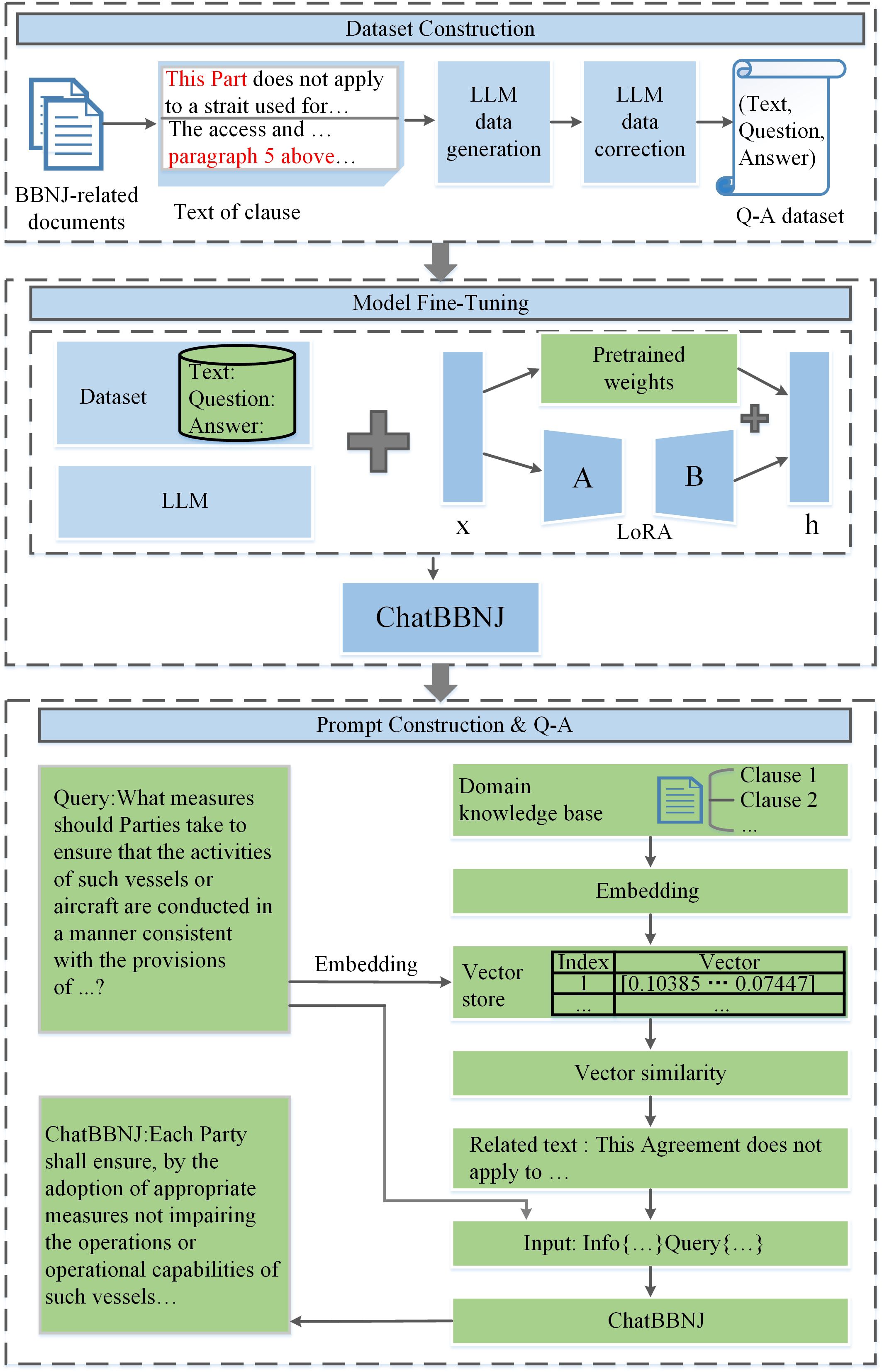
Figure 2 Overview of biodiversity of areas beyond national jurisdiction knowledge question–answering.
2.1 Q-A dataset construction
The proposed PDGC method comprises three modules: text preprocessing, data generation, and data correction (Figure 3). During the text preprocessing, we performed reference completion as the BBNJ-related documents have many reference expressions. Then, during the data generation, since the BBNJ-related documents are multidisciplinary, involving legal, scientific, and international relations considerations (Humphries et al., 2021), single data generation will result in a significant amount of noisy data. To solve this problem, a two-stage data generation method was applied. Finally, during the data correction, existing consistency validation methods reduce data quantity and diversity. Therefore, we proposed a similarity-based data division and iterative correction method.
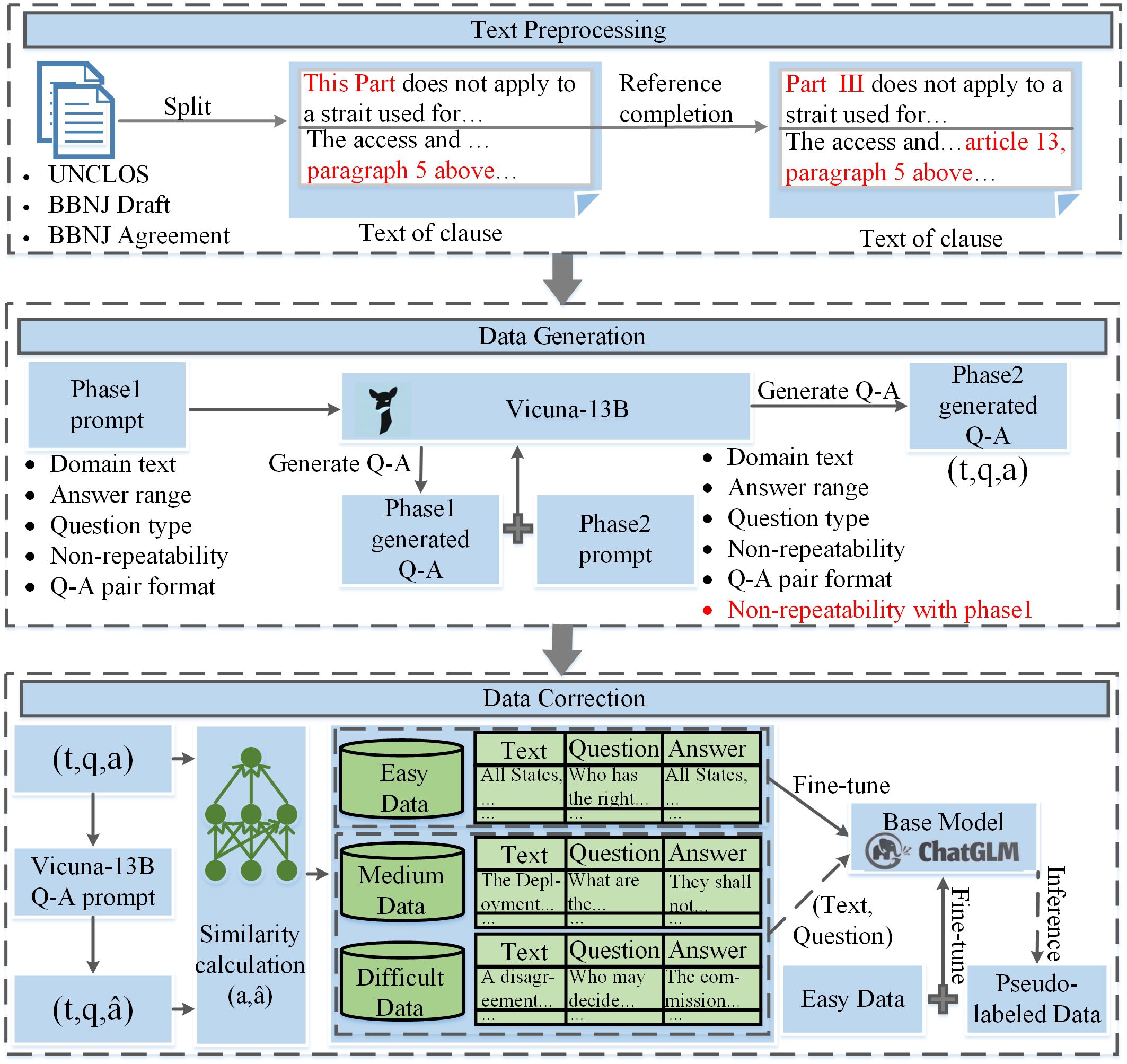
Figure 3 Dataset construction method framework. “UNCLOS” represents the United Nations Convention on the Law of the Sea. “BBNJ Draft” represents the draft agreement under the United Nations Convention on the Law of the Sea on the conservation and sustainable use of marine biological diversity of areas beyond national jurisdiction. “BBNJ Agreement” represents the agreement under the United Nations Convention on the Law of the Sea on the conservation and sustainable use of marine biological diversity of areas beyond national jurisdiction. “Vicuna-13B” is a large language model used to generate data. “ “ contains three parts: “ “ is the text of clause obtained in text preprocessing, “ “ and “ “ represent the question and answer generated by Vicuna-13B in data generation respectively. “ “ contains three parts: “ “ and “ “ are the same as “ “ and “ “ in “ “, but “ “ represents the new answer generated using “Vicuna-13B Q-A prompt” for data correction. “ChatGLM” is a large language model used to revise data.
2.1.1 Text preprocessing
BBNJ-related documents were collected to build our dataset. The details are shown in Table 1. In our study, text preprocessing consists of two steps: (1) division of regulations; and (2) reference completion. Division of regulations divides regulations into multiple paragraphs according to their clauses. As some clauses list multiple contents when describing “requirements” and “steps”, they often go beyond the input limit of the data generation model. Therefore, we took each part of the clause as a paragraph and supplemented Q-A pairs to ensure completeness. In addition, all the section titles were merged with any sentence within the corresponding section to retain semantic information. Reference completion ensures that each clause retains complete semantic information. Lots of clauses use referential terms such as “above” and “this section” in their descriptions, they lose complete semantic information after the division of regulations. Therefore, we completed the reference to the terms according to the context. Finally, 3,089 BBNJ-related paragraphs were obtained and used for Q-A data generation.
2.1.2 Data generation
Preliminary evaluation using GPT-4 as a judge shows that Vicuna-13B achieves more than 90% quality of OpenAI’s ChatGPT (Chiang et al., 2023). Since ChatGPT (Ouyang et al., 2022) is in a non-open source state, we applied open source Vicuna-13B as the base model for data generation to minimize experimental costs.
Prompting is a method for guiding the LLMs toward desired outputs. To achieve the best performance of LLMs in data generation, proper design of prompts is essential. We designed prompts for generating data at different stages. In the first stage, we used BBNJ-related paragraphs as input to generate Q-A pairs based on the content of the Phase 1 data generation prompt shown in Figure 4. In the second stage, following the concept of in-context learning (Dong et al., 2023), BBNJ-related paragraphs and Q-A pairs generated in Phase 1 were used as input to generate higher-quality Q-A pairs based on the content of the Phase 2 data generation prompt shown in Figure 5. Although it has been clearly stated in the prompt that LLMs need to generate new questions different from the examples, it was found that there were still occurrences of repetitive Q-A pairs during the experiment. Therefore, after the question generation process, it is necessary to carry out a deduplication operation on the generated Q-A pairs. After deduplication, we obtained 29,273 Q-A pairs, .
2.1.3 Data correction
To further improve the quality of the generated data, the data correction module depicted in Figure 6 is applied to revise the generated Q-A pairs. Since the LLMs will generate out-of-scope answers, we obtained new model-generated answers based on the content of the Vicuna-13B Q-A prompt shown in Figure 7. Then, we removed Q-A pairs with “no answer” and obtained new pairs . The data were divided into three levels: easy, medium, and difficult by calculating the similarity between and .
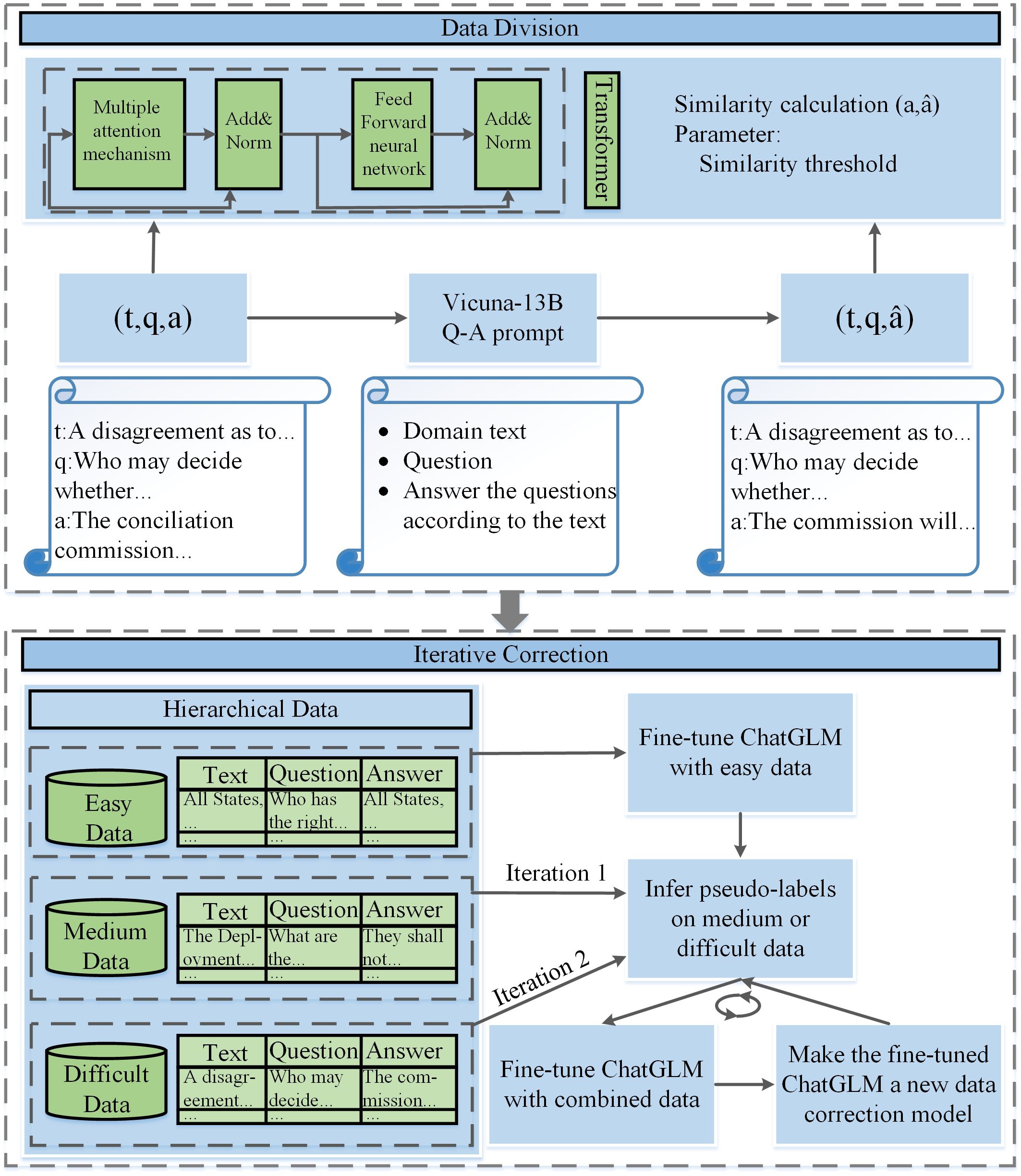
Figure 6 Data correction module. “ “ is obtained from data generation. “ “ and “ “ in “ “ are the same as “ “ and “ “ in “ “, but “ “ is the new model-generated answer using the “Vicuna-13B Q-A prompt”. During data division, first, we use the “Vicuna-13B Q-A prompt” to obtain and ; finally, we obtain the divided data including easy, medium and difficult levels. During iterative correction, first, we fine-tune the ChatGLM using only easy data; then, we use the supervised fine-tuned model to infer pseudo-labels on medium data and form the pseudo-labels in memory; then, we use the model, which accesses the pseudo-labels in memory to infer pseudo-labels on difficult data; finally, we obtain an annotated biodiversity of areas beyond national jurisdiction domain dataset.
To minimize the computational resources used for model fine-tuning during the data correction, ChatGLM (Zeng et al., 2022) is used as the base model for data correction, which has only 6.2 billion parameters. Inspired by (Wang et al., 2021), we optimized the data correction model iteratively by increasing the difficulty of the Q-A pairs fed to the model gradually. First, we used easy Q-A pairs to conduct the initial fine-tuning of ChatGLM, and used the fine-tuned model to reannotate the medium Q-A pairs. Then, we further fine-tuned the model using the reannotated data and used the model obtained after this fine-tuning to reannotate the difficult Q-A pairs. Thus, the abilities of Vicuna-13B are transferred to ChatGLM for data correction in low-resource settings. Finally, 18,296 annotated Q-A pairs of BBNJ domain were obtained.
2.2 Model fine-tuning
To improve the domain adaptation ability of LLMs applied to BBNJ domain, we fine-tuned the LLMs by using the BBNJ domain Q-A dataset constructed in Section 2.1. ChatGLM is applied as the base model. The open-source nature of the model is an important consideration.
To minimize the computational resources used for model fine-tuning, we applied the commonly used LoRA technique (Hu et al., 2021), which has been shown to effectively adapt LLMs to specific domain tasks and improve their performance (Lukichev et al., 2023). LoRA applies a simple linear design that allows the trainable matrix to be combined with frozen weights during model deployment. Compared with fully fine-tuned models, this approach does not create inference latencies, which is necessary for a knowledge Q-A system.
Data processing is necessary when fine-tuning ChatGLM. Research shows that ChatGLM and other LLMs can generalize well to unseen tasks and follow task descriptions after instruction tuning (Wei et al., 2021). However, LLMs have some weaknesses when lacking instructions, such as repetitive output and difficulty in fulfilling researchers’ expected task types. Therefore, it is necessary to construct the training set based on the organization of data in instruction tuning before fine-tuning. Each training data used for instruction tuning consists of three parts: instruction, question, and answer. Table 2 shows an example of the BBNJ domain Q-A dataset.
The ChatBBNJ model was obtained by using the LoRA technique to fine-tune ChatGLM for the BBNJ knowledge Q-A task.
2.3 Domain knowledge-based prompt engineering
The training data for the ChatBBNJ model is limited to a specific time period, the model cannot provide time-sensitive knowledge. To solve this problem, we applied the framework depicted in Figure 8 to the ChatBBNJ model.
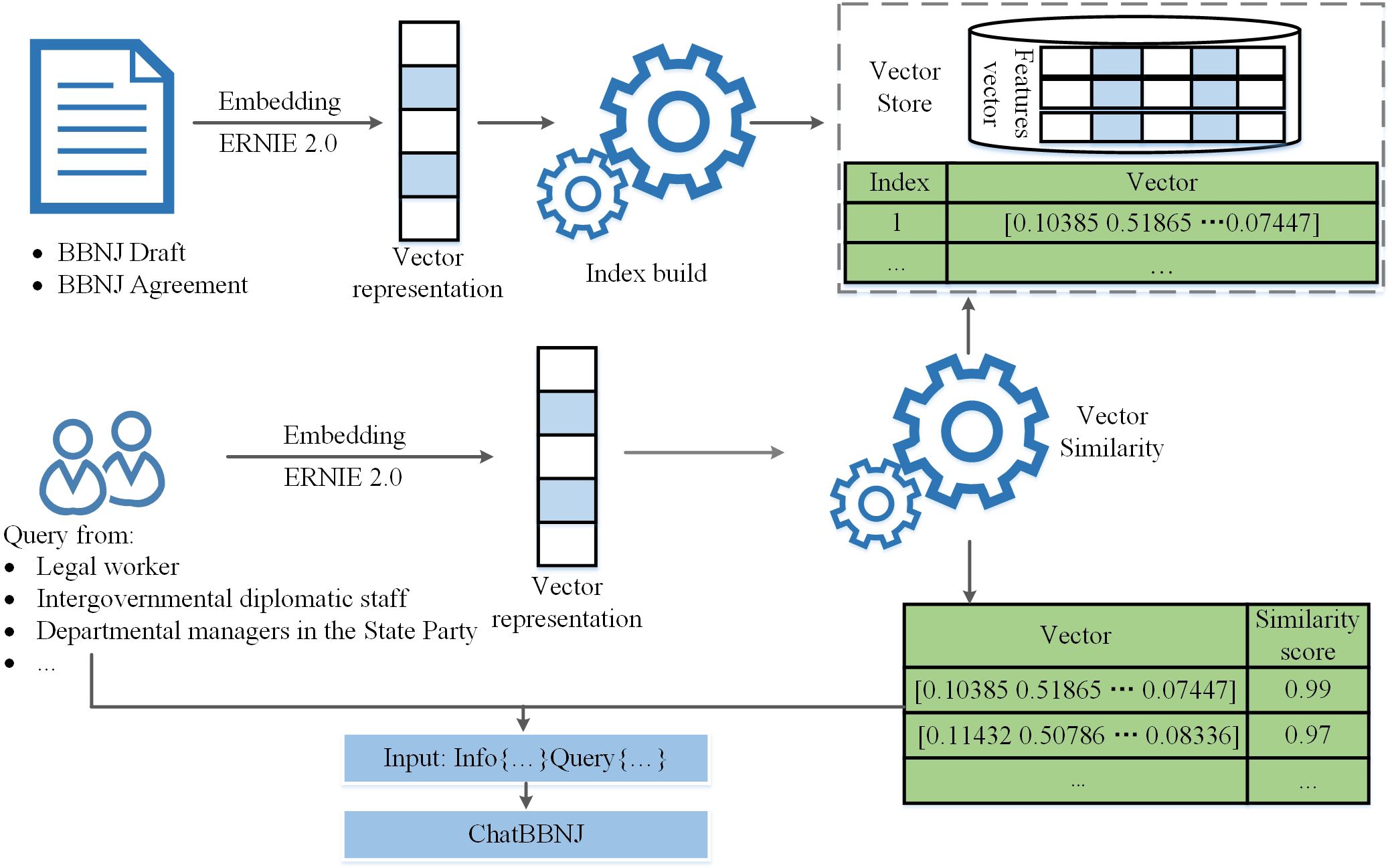
Figure 8 Domain knowledge-based prompt engineering framework. “BBNJ Draft” represents the draft agreement under the United Nations Convention on the Law of the Sea on the conservation and sustainable use of marine biological diversity of areas beyond national jurisdiction. “BBNJ Agreement” represents the Agreement under the United Nations Convention on the Law of the Sea on the conservation and sustainable use of marine biological diversity of areas beyond national jurisdiction.
First, we create the BBNJ domain knowledge base using BBNJ Agreement and its draft. Second, we applied ERNIE 2.0 (Sun et al., 2020) to obtain vectorized representations of the domain knowledge, which was stored in our vector database. When a user poses a question, it is first embedded and then indexed using semantic similarity to find the top-k nearest vectors corresponding to the inquiry. The dot product of two vectors is utilized to analyze the similarity between vector embeddings, which is obtained by multiplying their respective components and summing the results. After identifying the nearest vectors to the query vector, we decode the numeric vectors to text and retrieve the corresponding text from the database. The textual information and user question are used to improve ChatBBNJ’s prompt. This method enables users to receive reliable and up-to-date answers. The framework can be extended to other domains that require periodic knowledge updates.
3 Experiment
3.1 Baseline
To assess the performance of the proposed ChatBBNJ, we performed a comparative analysis using its base model ChatGLM and two additional language models.
LLaMA (Touvron et al., 2023a) is a collection of foundation language models ranging from 7 to 65 billion parameters, these models are trained using publicly available data. The experimental results demonstrate that LLaMA-7B outperforms GPT-3 in several natural language processing benchmark tests without relying on domain datasets.
Vicuna-13B (Chiang et al., 2023) is an open-source chatbot trained by fine-tuning LLaMA on user-shared conversations collected from ShareGPT. Preliminary evaluation using GPT-4 as a judge showed that Vicuna-13B achieved more than 90% quality of OpenAI’s ChatGPT and Google’s Bard.
3.2 Evaluation metrics
The models used in this study provide knowledge answers using a generative method. Traditional generative task evaluation metrics only consider word matching, they cannot provide a reasonable assessment for expressions with the same semantics. Thus, we applied the BERTScore (Zhang et al., 2019) to evaluate semantic equivalence. The precision, recall, and F1-scores were computed. Equations (1-3) provide the calculation methods for the evaluation metrics, where represents the ground-truth answers in the test set and represents the answers from ChatBBNJ and baselines.
3.3 Results
We demonstrated the effectiveness of our method framework, the efficacy of its individual modules, and the Q-A performance of ChatBBNJ quantitatively through experiments. We divided the BBNJ domain dataset constructed in Section 2.1 into training and testing sets with ratios of 77 and 23%, respectively.
First, we compared ChatBBNJ with several other LLMs in Q-A tasks. To quantitatively evaluate the performance of ChatBBNJ, we calculated the metrics for both baselines in Section 3.1 and ChatBBNJ. The results are shown in Figure 9. The results show that ChatBBNJ achieves significantly higher precision, recall, and F1-scores, compared to baselines. The results show that ChatBBNJ achieves 0.097 precision, 0.025 recall, and 0.062 F1-scores improvement over its base model ChatGLM. These results demonstrate that ChatBBNJ exhibits superior expertise in the BBNJ domain.
Second, we conducted ablation experiments to demonstrate the efficacy of individual modules in our method framework. To quantitatively evaluate the effectiveness of the three proposed modules, namely PDGC for BBNJ domain dataset construction, model fine-tuning, and domain knowledge-based prompt engineering, we also calculated the metrics under different scenarios. The complete evaluation results are shown in Table 3. The quality of training data influences how well the model learns. Therefore, to evaluate the effectiveness of PDGC, we fine-tuned the model for Q-A task before and after using PDGC, then tested the model’s performance. The results indicate that the model’s Q-A performance improves after fine-tuning the model with data generated by PDGC. Additionally, fine-tuning the model helps enhance its performance. We find that the model achieves improvement over ChatGLM. To evaluate the effectiveness of the domain knowledge-based prompt engineering, we also compared the Q-A performance before and after using this module. The results indicate that the model performs better after using the domain knowledge-based prompt engineering when other modules are the same. The results indicate that the model incorporating with each of our module achieves higher precision, recall and F1-scores in all cases.
Finally, we demonstrate the effectiveness of ChatBBNJ through specific Q-A examples. The examples generated by ChatBBNJ and baseline models are listed in Table 4, Table 5 and supplementary materials. In the tables, “Q” represents the question provided to the models. “ChatGLM”, “LLaMA-7B”, “Vicuna-13B”, and “ChatBBNJ” represent the answers generated by the models. “Answer” represents the ground-truth answer. We underline the key points of the models’ answers.
In Table 4, we provide a question related to BBNJ domain terminology. ChatGLM considers “area-based management tool” to be a software application, LLaMA-7B categorizes as manager and employee resource management, their answers deviate from the BBNJ domain. Vicuna-13B’s answer is more inclusive, but it lacks domain specificity. Our ChatBBNJ provides an answer that reflects the BBNJ domain specificities and includes most of the key points from the ground-truth answer.
In Table 5, we provide a time-sensitive question related to the BBNJ domain. This question is regulated first in the BBNJ Agreement, which was formally adopted in August 2023. The answers from ChatGLM, LLaMA-7B, and Vicuna-13B are related to the COP but not to the BBNJ domain, and ChatGLM displayed language inconsistencies. It can be seen that ChatGLM's answer is a mixture of Chinese and English format, the answer includes "会议室"(conference room)、"会议设施"(conference facilities) and other Chinese format. ChatGLM’s knowledge is cut off in 2022. However, ChatBBNJ, which is based on ChatGLM, provides correct BBNJ domain answers based on knowledge in 2023.
In Supplementary Table 1, we provide two Q-A examples for complex application scenario. The answers of ChatGLM, LLaMA-7B and Vicuna-13B use terms from the BBNJ Agreement rarely, especially ChatGLM expresses ABMT as ABM tools in Q2, which is not conform to the treaty. Besides, ChatGLM's answer is a mixture of Chinese and English format, it includes "寻求国际协作, 以解决这一问题" (seek international cooperation to solve this problem), "采取可持续的措施" (take sustainable measures) and other Chinese format. However, ChatBBNJ not only provides the original text from the Agreement in Q2, but also emphasizes the necessity of the relevant reports and the role of the United Nations in Q1, which make the answers more comprehensive. It can be seen that compared to other models, our ChatBBNJ can provide answers more aligned with the BBNJ Agreement in complex scenarios, especially in Q2, where ChatBBNJ provides almost all requirements related to ABMTs in the BBNJ Agreement.
In Supplementary Table 2, we provide two Q-A examples for the interpretation of the BBNJ Agreement under Article 31 of the Vienna Convention on the Law of Treaties (VCLT). Article 31 of the VCLT can be summarized as: be interpreted in good faith, be interpreted in the light of treaty’s object and purpose, be interpreted with supplementary means of interpretation, be interpreted in accordance with the ordinary meaning and be interpreted with the terms of the treaty in their context. In Q1, ChatBBNJ’s response highlights the importance of international cooperation in marine scientific research and technology development in first sentence, which complies with the principle of good faith interpretation. And the first sentence also links to the objective of the treaty. Moreover, ChatBBNJ’s response provides relevant contents from Article 143 of the UNCLOS, reflecting supplementing interpretation based on external materials. In Q2, ChatBBNJ provides an ordinary explanation of “transparency”, supplemented it with interpretations of the term in different contexts, and provide the role of transparency as well as the challenges it faces. This response reflects an ordinary meaning interpretation. Besides, ChatBBNJ provides some measures involved in the BBNJ Agreement, including making decisions and documents open to the public, open meeting practices, publishing and maintaining a public record of decisions and publishing decision information. These measures come from different articles in the agreement, which reflects interpreting with the terms of the treaty in their context.
The latest versions of the baseline models (e.g., ChatGLM2 and LLaMA2-7B (Touvron et al., 2023b)) had improved abilities over ChatGLM and LLaMA-7B used in this study. Since we applied the ChatGLM as a base model, we compared ChatBBNJ with the latest baseline models, ChatGLM2 and LLaMA2-7B. The results are shown in Table 6. The results show that our ChatBBNJ outperforms the more advanced ChatGLM2 and LLaMA2-7B. These findings suggest that our method framework for BBNJ domain Q-A, significantly enhance the performance of the LLMs in the BBNJ domain.
4 Discussion
Over the past 50 years, the degradation of marine biodiversity in ABNJ persists, with a lack of effective governance mechanisms to halt this decline (Ward et al., 2022). Industrial fishing affects about 50% of oceans (Sala et al., 2018), leading to overexploitation of 31% of marine fish stocks (FAO, 2016), and ecosystem-level alterations in high seas (Ortuño Crespo and Dunn, 2017). The international maritime order is dynamic and evolving, and UNCLOS’ authoritative, comprehensive, and extended nature does not imply its perfection. Due to the game of interests and compromise among countries, many UNCLOS rules are principled and articulated, creating legal ambiguities that often need to be further addressed in practice. The current international ocean order is in a state of rapid transition, necessitating a reaction to several earth system changes such as sea-level rise, plastic pollution of the seas, acidification, and destruction of marine biodiversity (Chen and Liu, 2023). BBNJ agreement is intended to serve as a governance mechanism for the protection and sustainable use of marine biodiversity in the ABNJ.
The present study introduces ChatBBNJ, a question-answering system, that designed to enhance the treaty implementation. First, we proposed PDGC, a data engineering method, that constructs a high-quality Q-A dataset specific to the BBNJ domain. Second, we applied this dataset to fine-tune the ChatGLM to obtain the BBNJ domain model, ChatBBNJ. Finally, we introduced a domain knowledge-based prompt engineering. We demonstrated improvements by testing ChatBBNJ on Q-A data related to the BBNJ Agreement and its draft. Experiment results demonstrate that ChatBBNJ outperforms baseline LLMs across three Q-A metrics. Additionally, hybrid ChatBBNJ, which introduces a domain knowledge-based prompt framework outperforms standalone ChatBBNJ. The main findings of our work are summarized as follows:
(1) The quality of LLMs text generation can be enhanced through appropriate prompt engineering and data correction. The effectiveness of model training is to some extent related to the quality of training data. Therefore, Table 3 compares the Q-A performance of ChatBBNJ before and after using PDGC. It can be seen that the Q-A performance of ChatBBNJ improves when the model is fine-tuned with data generated by PDGC.
(2) The domain adaptation ability of LLMs in Q-A tasks can be improved by fine-tuning the model on domain-specific Q-A datasets. Analyzing the experimental results in Table 3, regardless of the method used for data generation, ChatBBNJ’s Q-A performance improves after model fine-tuning.
(3) The outdated issues of LLMs can be refined by giving the model access to the knowledge beyond its fine-tuning phase time and instructing LLMs on how to utilize that knowledge. In Table 5, the model was asked a time-sensitive question, with relevant information not within the model’s training data. However, our ChatBBNJ, equipped with the domain knowledge-based prompt engineering, accessed external knowledge and provided the correct answer.
(4) This study not only demonstrates the feasibility of BBNJ knowledge acquisition by using Q-A system but also provides a method framework to apply Q-A system in BBNJ domain. The method framework has three parts. Firstly, domain datasets are acquired using data engineering method. Secondly, LLMs are fine-tuned for Q-A task based on the generated datasets. Finally, a domain knowledge-based prompt engineering is employed to assist the model in accessing the latest information, ensuring the timeliness of its responses.
In the future, the successful application of ChatBBNJ can bring several benefits. From the perspective of the representatives who have not participated in BBNJ negotiations, they can acquire BBNJ knowledge and avoid reading a large number of irrelevant documents. Simultaneously, governments can benefit from the Q-A system. The BBNJ Agreement calls for parties to take the necessary legislative measures to ensure the implementation of this agreement (United Nations, 2023). ChatBBNJ can provide popularization and interpretation of the agreement, which is helpful to assist governments in enacting implementation legislation. The successful implementation of the proposed ChatBBNJ will make a substantial contribution towards prompting the effectie implementation of the BBNJ Agreement, which will hopefully result in the conservation and sustainable use of marine biodiversity in ABNJ.
However, the limitations of this study remain. First, the accuracy of ChatBBNJ needs to be improved. The present system has achieved reasonable accuracy in the current research field, but there is still room for improvement. Second, the sources of knowledge need to be expanded. The present study mainly focused on promoting the implementation of the BBNJ Agreement, but the methods can be applied to more implementation in international agreements in the law of the sea domain. In future research, more international law of the sea data will be added to the study to obtain richer knowledge and expand the scope of applications.
Data availability statement
The raw data supporting the conclusions of this article will be made available by the authors, without undue reservation.
Author contributions
XW: Conceptualization, Data curation, Formal Analysis, Investigation, Methodology, Project administration, Software, Validation, Visualization, Writing – original draft, Writing – review & editing. MZ: Data curation, Formal analysis, Writing – review & editing. HL: Conceptualization, Resources, Supervision, Writing – review & editing. XM: Project administration, Validation, Writing – original draft. YL: Project administration, Writing – original draft. YC: Conceptualization, Data curation, Formal Analysis, Funding acquisition, Resources, Supervision, Writing – review & editing.
Funding
The author(s) declare financial support was received for the research, authorship, and/or publication of this article. This research was funded by the National Social Science Fund of China, Grant No. 20CFX082.
Acknowledgments
We would like to thank the computing resources and the professional technical guidance provided by Hao Liu. Thanks to Mittens and Panda.
Conflict of interest
The authors declare that the research was conducted in the absence of any commercial or financial relationships that could be construed as a potential conflict of interest.
Publisher’s note
All claims expressed in this article are solely those of the authors and do not necessarily represent those of their affiliated organizations, or those of the publisher, the editors and the reviewers. Any product that may be evaluated in this article, or claim that may be made by its manufacturer, is not guaranteed or endorsed by the publisher.
Supplementary material
The Supplementary Material for this article can be found online at: https://www.frontiersin.org/articles/10.3389/fmars.2024.1368356/full#supplementary-material
References
Amer-Yahia S., Bonifati A., Chen L., Li G. L., Shim K., Xu J. L., et al. (2023). From large language models to databases and back: A discussion on research and education. SIGMOD Rec. 52, 49–56. doi: 10.1145/3631504.3631518
Bengio Y., Ducharme R., Vincent P., Jauvin C. (2003). A neural probabilistic language model. JMLR 3, 1137–1155. doi: 10.1162/153244303322533223
Bodansky D. (2011). Implementation of international environmental law. Jpn. Yearb. Int. Law. 54, 62–96.
Chen Y. T., Liu H. R. (2023). Critical perspectives on the new situation of global ocean governance. Sustainability 15, 10921. doi: 10.3390/su151410921
Chiang W.-L., Li Z., Lin Z., Sheng Y., Wu Z., Zhang H., et al. (2023) Vicuna: an open-source chatbot impressing GPT-4 with 90%* chatGPT quality. Available online at: https://lmsys.org/blog/2023-03-30-vicuna/ (Accessed November 4, 2023).
Common Crawl (2023). Available online at: https://commoncrawl.org/ (Accessed November 4, 2023).
Cui J. X., Li Z. J., Yan Y., Chen B. H., Yuan L. (2023). ChatLaw: open-source legal large language model with integrated external knowledge bases. arXiv. doi: 10.48550/arXiv.2306.16092
Dai F., Zhao Z., Sun C., Li B. (2022). “Intelligent audit question answering system based on knowledge graph and semantic similarity,” in 2022 11th International Conference of Information and Communication Technology (ICTech), Wuhan, China: IEEE. 125–132. doi: 10.1109/ICTech55460.2022.00033
Deasy K. (2023). What we know about the new high seas treaty. NPJ Ocean Sustain. 2, 7. doi: 10.1038/s44183-023-00013-x
Devlin J., Chang M.-W., Lee K., Toutanova K. (2019). BERT: pretraining of deep bidirectional transformers for language understanding. arXiv. doi: 10.48550/arXiv.1810.04805
Dong Q. X., Li L., Dai D. M., Zheng C., Wu Z. Y., Chang B. B., et al. (2023). A survey on in-context learning. arXiv. doi: 10.48550/arXiv.2301.00234
Eloundou T., Manning S., Mishkin P., Rock D. (2023). GPTs are GPTs: an early look at the labor market impact potential of large language models. arXiv. doi: 10.48550/arXiv.2303.10130
FAO (2016) The state of world fisheries and aquaculture 2016. contributing to food security and nutrition for all (Rome, Italy: Food and Agriculture Organization of the United Nations). Available online at: https://www.fao.org/3/i5555e/i5555e.pdf (Accessed March 4, 2024).
Hu E. J., Shen Y. L., Wallis P., Allen-Zhu Z., Li Y. Z., Wang S. A., et al. (2021). LoRA: low-rank adaptation of large language models. arXiv. doi: 10.48550/arXiv.2106.09685
Huang Q. Z., Tao M. X., An Z. W., Zhang C., Jiang C., Chen Z. B., et al. (2023). Lawyer LLaMA technical report. arXiv. doi: 10.48550/arXiv.2305.15062
Humphries F., Harden-Davies H. (2020). Practical policy solutions for the final stage of BBNJ treaty negotiations. Mar. Policy. 122, 104214. doi: 10.1016/j.marpol.2020.104214
Humphries F., Rabone M., Jaspars M. (2021). Traceability approaches for marine genetic resources under the proposed ocean (BBNJ) treaty. Front. Mar. Sci. 8. doi: 10.3389/fmars.2021.661313
Kaplan J., McCandlish S., Henighan T., Brown T. B., Chess B., Child R., et al. (2020). Scaling laws for neural language models. arXiv. doi: 10.48550/arXiv.2001.08361
Lau G. T., Law K. H., Wiederhold G. (2005). “Legal information retrieval and application to e-rulemaking,” in Proceedings of the 10th International Conference on Artificial Intelligence and Law, ICAIL’05 (Association for Computing Machinery, New York, NY), 146–154. doi: 10.1145/1165485.1165508
Lee S.-H., Choi S.-W., Lee E.-B. (2023). A question-answering model based on knowledge graphs for the general provisions of equipment purchase orders for steel plants maintenance. Electronics 12, 2504. doi: 10.3390/electronics12112504
Li Y. X., Li Z. H., Zhang K., Dan R. L., Jiang S., Zhang Y. (2023). ChatDoctor: A medical chat model fine-tuned on a large language model meta-AI (LLaMA) using medical domain knowledge. Cureus 15, e40895. doi: 10.7759/cureus.40895
Li J. L., Zhang Z. S., Zhao H. (2023). Self-prompting large language models for zero-shot open-domain QA. arXiv. doi: 10.48550/arXiv.2212.08635
Lukichev D., Kryanina D., Bystrova A., Fenogenova A., Tikhonova M. (2023). “Parameter-efficient tuning of transformer models for Anglicism detection and substitution in Russian,” in Proceedings of the International Conference “Dialogue 2023.” Available at: https://www.dialog-21.ru/media/5911/lukichevdplusetal042.pdf (Accessed April 3, 2024).
Ortuño Crespo G., Dunn D. C. (2017). A review of the impacts of fisheries on open-ocean ecosystems. ICES J. Mar. Sci. 74, 2283–2297. doi: 10.1093/icesjms/fsx084
Ouyang L., Wu J., Jiang X., Almeida D., Wainwright C., Mishkin P., et al. (2022). Training language models to follow instructions with human feedback., in Advances in Neural Information Processing Systems. Curran Associates, Inc., 27730–27744. Available at: https://proceedings.neurips.cc/paper_files/paper/2022/file/b1efde53be364a73914f58805a001731-Paper-Conference.pdf (Accessed April 3, 2024).
Riloff E., Thelen M. (2000). “A rule-based question answering system for reading comprehension tests,” in ANLP-NAACL 2000 workshop: reading comprehension tests as evaluation for computer-based language understanding systems, (Seattle, WA, USA: ACL). Vol. 6. 13–19. doi: 10.3115/1117595.1117598
Rosenfeld R. (2000). Two decades of statistical language modeling: where do we go from here? Proc. IEEE 88, 1270–1278. doi: 10.1109/5.880083
Sala E., Mayorga J., Costello C., Kroodsma D., Palomares M. L. D., Pauly D., et al. (2018). The economics of fishing the high seas. Sci. Adv. 4, eaat2504. doi: 10.1126/sciadv.aat2504
Sun Y., Wang S. H., Li Y. K., Feng S. K., Tian H., Wu H., et al. (2020). “ERNIE 2.0: a continual pre-training framework for language understanding,” in Proceedings of the AAAI Conference on Artificial Intelligence, (New York, USA: AAAI). Vol. 34. 8968–8975. doi: 10.1609/aaai.v34i05.6428
Tessnow-von Wysocki I., Vadrot A. B. M. (2020). The voice of science on marine biodiversity negotiations: a systematic literature review. Front. Mar. Sci. 7. doi: 10.3389/fmars.2020.614282
Tiller R., Mendenhall E., De Santo E. D., Nyman E. (2023). Shake it off: negotiations suspended, but hope simmering, after a lack of consensus at the fifth intergovernmental conference on biodiversity beyond national jurisdiction. Mar. Policy. 148, 105457. doi: 10.1016/j.marpol.2022.105457
Touvron H., Lavril T., Izacard G., Martinet X., Lachaux M.-A., Lacroix T., et al. (2023a). LLaMA: open and efficient foundation language models. arXiv. doi: 10.48550/arXiv.2302.13971
Touvron H., Martin L., Stone K., Albert P., Almahairi A., Babaei Y., et al. (2023b). Llama 2: open foundation and fine-tuned chat models. arXiv. doi: 10.48550/arXiv.2307.09288
United Nations (2023) Agreement under the united nations convention on the law of the sea on the conservation and sustainable use of marine biological diversity of areas beyond national jurisdiction. Available online at: https://undocs.org/en/A/77/L.82 (Accessed August 10, 2023).
Vaghefi S. A., Stammbach D., Muccione V., Bingler J., Ni J. W., Kraus M., et al. (2023). ChatClimate: Grounding conversational AI in climate science. Commun. Earth Environ. 4, 480. doi: 10.1038/s43247-023-01084-x
Wang X., Chen Y., Zhu W. (2021). A survey on curriculum learning. Proc. IEEE 44, 4555–4576. doi: 10.1109/TPAMI.34
Wang H. C., Liu C., Xi N. W., Qiang Z. W., Zhao S. D., Qin B., et al. (2023). HuaTuo: tuning LLaMA model with Chinese medical knowledge. arXiv. doi: 10.48550/arXiv.2304.06975
Wang Z. Z., Yang F. K., Zhao P., Wang L., Zhang J., Garg M., et al. (2023). Empower large language model to perform better on industrial domain-specific question answering. arXiv. doi: 10.48550/arXiv.2305.11541
Ward D., Melbourne-Thomas J., Pecl G. T., Evans K., Green M., McCormack P. C., et al. (2022). Safeguarding marine life: conservation of biodiversity and ecosystems. Rev. Fish Biol. Fisheries. 32, 65–100. doi: 10.1007/s11160-022-09700-3
Wei J., Bosma M., Zhao V. Y., Guu K., Yu A. W., Lester B., et al. (2021). Finetuned language models are zero-shot learners. arXiv. doi: 10.48550/arXiv.2109.01652
Wikipedia (2023). Available online at: https://en.wikipedia.org/wiki/MainPage (Accessed November 4, 2023).
Xiong H. L., Wang S., Zhu Y. T., Zhao Z. H., Liu Y. X., Huang L. L., et al. (2023). DoctorGLM: fine-tuning your Chinese doctor is not a herculean task. arXiv. doi: 10.48550/arXiv.2304.01097
Yang H. Y., Liu X.-Y., Wang C. D. (2023). FinGPT: open-source financial large language models. arXiv. doi: 10.2139/ssrn.4489826
Zeng A. H., Liu X., Du Z. X., Wang Z. H., Lai H. Y., Ding M., et al. (2022). GLM-130B: an open bilingual pre-trained model. arXiv. doi: 10.48550/arXiv.2210.02414
Zhang T. Y., Kishore V., Wu F. L., Weinberger K. Q., Artzi Y. (2019). BERTScore: evaluating text generation with BERT. arXiv. doi: 10.48550/arXiv.1904.09675
Zhong B., He W., Huang Z., Love P. E. D., Tang J., Luo H. (2020). A building regulation question answering system: a deep learning methodology. Adv. Eng. Inform. 46, 101195. doi: 10.1016/j.aei.2020.101195
Keywords: BBNJ agreement, ABNJ, LLMS, nlp, intelligent question-answering
Citation: Wang X, Zhang M, Liu H, Ma X, Liu Y and Chen Y (2024) ChatBBNJ: a question–answering system for acquiring knowledge on biodiversity beyond national jurisdiction. Front. Mar. Sci. 11:1368356. doi: 10.3389/fmars.2024.1368356
Received: 10 January 2024; Accepted: 26 March 2024;
Published: 08 April 2024.
Edited by:
Yen-Chiang Chang, Dalian Maritime University, ChinaReviewed by:
Nadia Khadam, Fatima Jinnah Women University, PakistanWen Duan, Hainan University, China
Copyright © 2024 Wang, Zhang, Liu, Ma, Liu and Chen. This is an open-access article distributed under the terms of the Creative Commons Attribution License (CC BY). The use, distribution or reproduction in other forums is permitted, provided the original author(s) and the copyright owner(s) are credited and that the original publication in this journal is cited, in accordance with accepted academic practice. No use, distribution or reproduction is permitted which does not comply with these terms.
*Correspondence: Yitong Chen, Y2hlbnlpdG9uZ0BvdWMuZWR1LmNu
 Xiaowei Wang
Xiaowei Wang Mingdan Zhang2
Mingdan Zhang2 Hao Liu
Hao Liu Xiaodong Ma
Xiaodong Ma Yingchao Liu
Yingchao Liu Yitong Chen
Yitong Chen